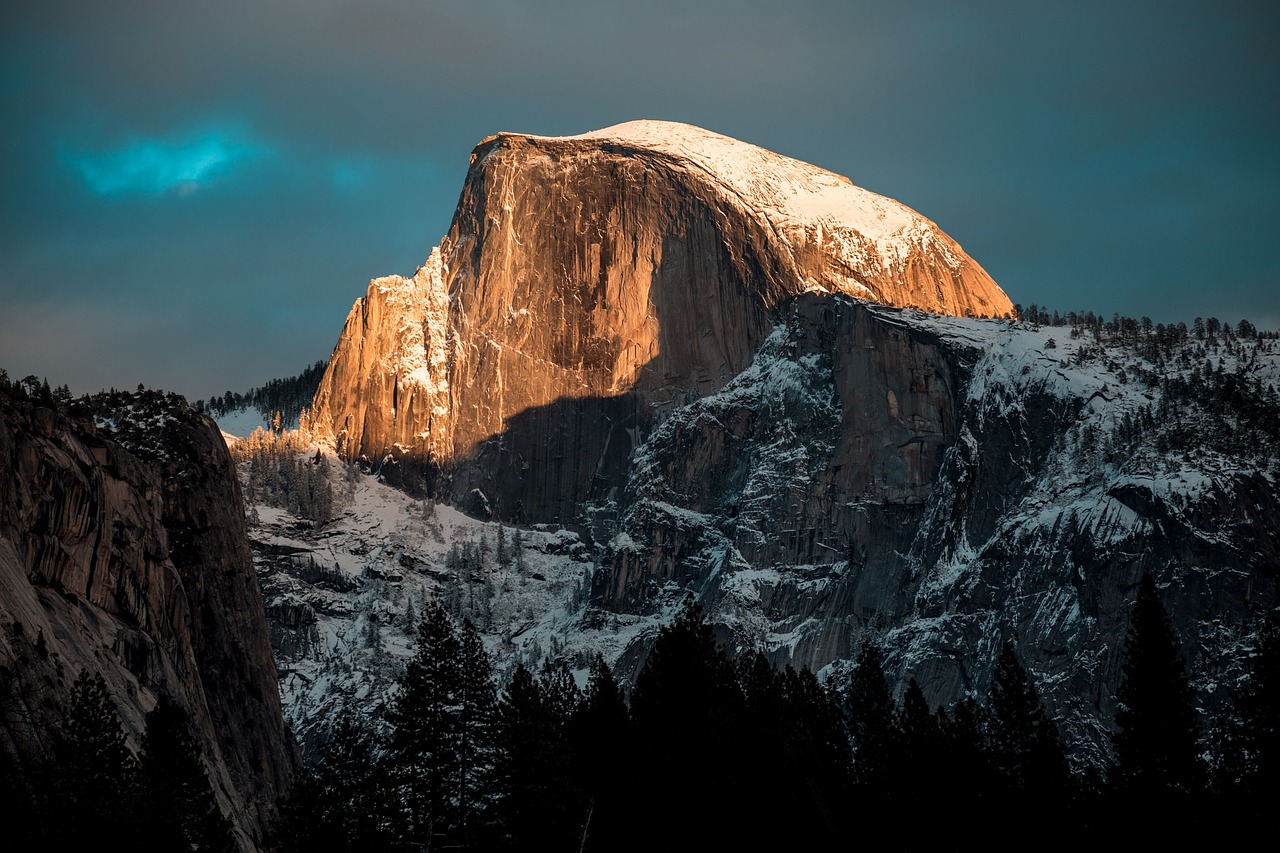Planning a vacation can be tough. Yosemite National Park is a gem in California’s Sierra Nevada mountains. This blog will guide you through its wonders. Get ready for an adventure!
Key Takeaways
- Yosemite was first protected in 1864 by the Yosemite Grant, making it a key part of U.S. conservation history.
- The park is home to famous landmarks like El Capitan, Half Dome, and giant sequoias in Mariposa Grove.
- Visitors can enjoy activities such as hiking, rock climbing, snow sports, and more throughout the year.
- Yosemite’s efforts focus on wildfire management and reducing climate change impacts to preserve its natural beauty.
- Accommodation options range from hotels and cabins to campgrounds, catering to various preferences.
History of Yosemite National Park
Yosemite National Park’s history dates back to 1864 when it was first protected as the Yosemite Grant. The park also has a rich Indigenous heritage with the Ahwahneechee people and its early days saw efforts in tourism and conservation.
The Yosemite Grant of 1864
In 1864, President Abraham Lincoln signed the Yosemite Grant. This act gave California land that included Yosemite Valley and Mariposa Grove of Giant Sequoias. It was a big step for conservation in America.
The grant aimed to protect these areas from harm.
This action marked the first time the U.S. government protected land for public use and enjoyment. People started to see the value in saving beautiful natural places. The Yosemite Grant laid groundwork for national parks in the United States.
Indigenous heritage and the Ahwahneechee people
Long before tourists and hikers explored its vast landscapes, Yosemite National Park was home to the Ahwahneechee people. They lived in the area for centuries. Their deep connection with the land is a key part of Yosemite’s heritage.
The Ahwahneechee hunted, fished, and gathered natural resources from the forests, meadows, and rivers.
They also understood how to use fire as a tool. This helped them manage the land and support its ecosystems. Sadly, their way of life changed when settlers arrived in the 19th century.
Today, efforts are made to honor and remember the original inhabitants of this land through educational programs and conservation work that respects indigenous traditions.
Early tourism and conservation efforts
Tourists started coming to Yosemite in the 1850s, drawn by its natural beauty. Hotels and roads popped up to welcome them. People realized they needed to protect this place. John Muir, a nature lover, worked hard for it.
He helped make Yosemite a national park in 1890.
The government took steps too. They passed laws to keep the park safe for future generations. These efforts showed how important it is to care for our beautiful lands. Now, millions visit Yosemite every year, enjoying its wonders thanks to early actions taken long ago.
Iconic Landmarks in Yosemite
Admire the towering presence of El Capitan and Half Dome as they dominate the Yosemite landscape. Feel the mist on your face as you stand before Yosemite Falls and Bridalveil Fall, marveling at their grandeur.
Immerse yourself in the ancient wonders of Mariposa Grove, home to some of Earth’s oldest living organisms.
El Capitan and Half Dome
Yosemite’s El Capitan and Half Dome are legendary granite formations that draw adventurers and photographers from all over the world. El Capitan, a massive 3,000-foot vertical rock formation, is a mecca for rock climbers seeking an adrenaline rush.
On the other hand, Half Dome’s iconic shape has made it one of Yosemite’s most photographed landmarks, with its challenging hike providing breathtaking views of the valley below. These towering monoliths showcase nature at its most magnificent.
Visitors can take in these marvels by driving along Northside Drive for stunning perspectives or hiking up to Glacier Point or Taft Point for panoramic views of both formations across the valley floor.
The incredible scale and beauty of El Capitan and Half Dome make them must-see attractions for anyone exploring Yosemite National Park.
Yosemite Falls and Bridalveil Fall
Moving on from the towering peaks of El Capitan and Half Dome, you’ll find two iconic waterfalls in Yosemite National Park – Yosemite Falls and Bridalveil Fall. 1,430 feet high, Yosemite Falls is one of the tallest falls in North America.
The falls consist of three separate sections: Upper Yosemite Fall (1,430 feet), Middle Cascades (675 feet), and Lower Yosemite Fall (320 feet). It’s a breathtaking sight that draws countless visitors each year.
Nearby, Bridalveil Fall plunges 620 feet down into the valley and is renowned for its ethereal beauty.
Both falls are easily accessible via short hikes or overlooks, making them must-see attractions during your visit to this magnificent park. Be prepared to witness these natural wonders in their full splendor as they cascade through the granite cliffs amidst lush greenery.
Mariposa Grove of Giant Sequoias
Mariposa Grove, located in Yosemite National Park, is home to over 500 mature giant sequoias, making it one of the largest groves of these majestic trees in the world. Some of these giants are even more than 1,000 years old and stand over 280 feet tall.
The most famous among them is the Grizzly Giant, which has a base circumference of over 90 feet, making it one of the oldest living organisms on Earth. Visitors can explore this awe-inspiring forest via well-maintained trails that offer an up-close view of these towering ancient trees.
Walking through this grove provides an incredible opportunity to witness nature’s grandeur and experience the unique magic that only giant sequoias can offer.
The Mariposa Grove also features the California Tunnel Tree – one whose base was carved out in the late 19th century to allow horse-drawn carriages to pass through – a novelty from a bygone era when such practices were viewed as acceptable.
Today, visitors can marvel at its resilience and learn about how our perspectives on conservation have evolved over time while enjoying all that this enchanting natural wonder has to offer.
Geology and Natural Features
Yosemite National Park is known for its granite cliffs, mighty waterfalls, and diverse ecosystems, inviting visitors to explore the unique geology and natural beauty of this iconic park.
There’s so much more waiting to be discovered!
Granite cliffs and glacial formations
Yosemite National Park is renowned for its striking granite cliffs and glacial formations such as the iconic El Capitan and Half Dome. These colossal rock formations are the result of ancient geological processes, including volcanic activity and erosion, sculpted by glaciers over millions of years.
The park’s unique landscape showcases towering peaks, sheer cliffs, and U-shaped valleys carved by advancing glaciers during the last Ice Age.
The stunning glacial formations in Yosemite National Park also include breathtaking waterfalls like Yosemite Falls and Bridalveil Fall, which cascade from rugged granite precipices.
Additionally, Glacier Point provides an awe-inspiring vantage point to marvel at the park’s glacier-carved terrain. As visitors explore these natural wonders on hiking trails or scenic drives throughout the park, they can witness firsthand the captivating beauty created by ancient ice movements in this extraordinary wilderness.
Rivers, lakes, and meadows
Yosemite National Park is known for its beautiful rivers, serene lakes, and expansive meadows. The park boasts 3,200 lakes and two major rivers, the Tuolumne and Merced Rivers. These water bodies provide picturesque settings for various activities such as fishing, rafting, and swimming.
The famous Tuolumne Meadows offer a chance to take in the stunning scenery with easy walks along the riverbanks.
The lush meadows of Yosemite are home to diverse plant species like wildflowers and grasses. They also support an array of wildlife including deer, black bears, and coyotes. The idyllic landscapes create perfect picnic spots or lovely places to simply relax and soak in the natural beauty of Yosemite National Park.
Unique ecosystems and habitats
The diverse landscapes of Yosemite National Park give rise to unique ecosystems and habitats. From the towering granite cliffs to the serene meadows, this park is a haven for a variety of plant and animal life.
Within its boundaries lie more than 400 species of vertebrates, over 1,000 types of flowering plants, and about 37% of California’s native species.
This national treasure also boasts a mix of ecological communities including alpine woodlands, lush forests, subalpine meadows, and riparian areas along rivers and streams. These provide vital homes for black bears, mule deer, bobcats, foxes, and numerous bird species amidst stunning scenery that captivates visitors from around the world.
Activities for Visitors
Explore Yosemite through various hiking trails for all skill levels and revel in the thrill of rock climbing and mountaineering, or engage in winter activities and snow sports. Immerse yourself in the park’s diverse landscapes while partaking in outdoor adventures that suit every visitor’s interests.
Hiking trails for all skill levels
Yosemite National Park offers various hiking trails suitable for all levels of expertise, from beginners to experienced hikers. The park features easy routes like the Cook’s Meadow Loop and the Lower Yosemite Fall Trail, providing excellent opportunities for leisurely walks amidst stunning natural scenery.
For those seeking more challenging hikes, well-maintained trails such as the Mist Trail leading to Vernal Fall and Nevada Fall provide a thrilling experience with their steeper inclines and breathtaking views.
Visitors can also explore the iconic Tuolumne Meadows area, offering a range of moderate hikes through alpine meadows, surrounded by majestic mountain peaks. Additionally, those looking for longer excursions can explore parts of the John Muir Trail or embark on multi-day backpacking trips in designated wilderness areas within Yosemite National Park.
Rock climbing and mountaineering
After hiking the scenic trails, adventurous visitors can try rock climbing and mountaineering in Yosemite. El Capitan and Half Dome are famous for their challenging climbs, attracting climbers from all over the world.
With its sheer granite walls, El Capitan is a favorite among experienced climbers, while Half Dome offers a mix of cable-assisted climbing and natural rock routes. The park has over 1,000 climbing routes catering to various skill levels, making it a mecca for rock enthusiasts.
Mountaineers can also explore high-altitude ascents like Mount Lyell or Mount Dana within the park’s boundaries. These mountainous terrains offer exciting challenges for those seeking alpine adventures.
Yosemite’s exceptional terrain combined with its awe-inspiring views make it an unparalleled destination for thrill-seekers and outdoor enthusiasts alike.
Winter activities and snow sports
Yosemite National Park offers a range of winter activities and snow sports to enjoy. Visitors can explore the park’s stunning landscapes through cross-country skiing and snowshoeing on designated trails.
Snowboarding and downhill skiing are also popular at Badger Pass Ski Area, where visitors can experience thrill-packed runs, lessons, equipment rentals, and family-friendly slopes surrounded by breathtaking scenery.
For those seeking tranquility, opportunities for ice skating await in the heart of Yosemite Valley at Curry Village Ice Rink with awe-inspiring views of Half Dome as a backdrop. With an average annual snowfall of around 200 inches in higher elevations, Yosemite also provides excellent conditions for sledding and tubing adventures across various locations within the park.
These snowy pastimes offer unforgettable experiences amidst the natural beauty of one of America’s most iconic national parks.
Lodging and Camping Options
Discover comfortable accommodations in the heart of Yosemite Valley, surrounded by breathtaking natural beauty. Choose from a range of lodging options to suit your needs, from cozy cabins and rustic lodges to modern hotel rooms and campsites.
Yosemite Valley accommodations
Yosemite Valley offers various accommodation options, including lodges, hotels, and cabins. The Ahwahnee Hotel is a historic landmark with luxurious rooms and stunning views of the surrounding granite cliffs.
Additionally, for a more rustic experience, there are cozy cabins available in the Yosemite Valley Lodge area. Visitors can also choose to stay at campsites nestled within the valley for an authentic outdoor experience among the towering trees.
The accommodations provide convenient access to iconic landmarks such as Half Dome and El Capitan. Plus, they allow guests to easily explore the breathtaking waterfalls and meadows that make Yosemite National Park so extraordinary for nature lovers and adventure seekers alike.
Whether it’s relaxing in comfort or immersing oneself fully in nature, Yosemite Valley has options catering to different preferences.
Campgrounds and wilderness permits
Yosemite National Park offers various camping options, from developed campgrounds to wilderness permits for those seeking a backcountry experience. There are 13 popular campgrounds in Yosemite and more than 1,600 campsites.
From the high country to Wawona, each location provides distinct experiences surrounded by breathtaking natural beauty. Wilderness permits are required for all overnight backpacking trips at the park.
These permits help manage visitor use and protect the park’s wilderness.
Visitors should plan ahead as demand for both campgrounds and wilderness permits can be high, especially during peak seasons like summer. Reservations are available up to five months in advance and are recommended due to limited availability.
It’s important to carefully review the rules and regulations before securing your spot, ensuring an enjoyable and responsible stay within this treasured national park.
Conservation and Management
The park actively manages wildfires and works to address climate change. It focuses on preserving natural and cultural resources.
Addressing wildfires and climate change
Yosemite National Park faces challenges with wildfires due to drier conditions and warmer temperatures. The park actively manages its forests, conducts controlled burns, and uses firefighting techniques to prevent devastating wildfires.
Additionally, the park is working on reducing its carbon footprint through sustainable practices like energy-efficient buildings and transportation initiatives to address climate change impact.
The park collaborates with scientific researchers to monitor changes in climate and wildlife behavior influenced by environmental shifts. Yosemite also educates visitors about fire safety protocols and encourages them to participate in conservation efforts during their stay.
By continuing these initiatives, the park aims to protect its natural beauty for future generations while adapting to a changing environment.
Next: “Preservation of natural and cultural resources
Preservation of natural and cultural resources
After addressing wildfires and climate change, Yosemite National Park is focused on preserving its natural and cultural resources. The park offers educational programs to raise awareness about the importance of conservation.
Efforts are made to protect the diverse ecosystems and wildlife, including endangered species such as the Sierra Nevada bighorn sheep. Additionally, ongoing initiatives are in place to safeguard the historical sites and indigenous heritage within the park.
For example, Yosemite actively collaborates with Native American tribes to preserve their cultural traditions and ancestral lands.
The park’s visitor guidelines emphasize responsible tourism, encouraging travelers to respect nature and follow designated trails for minimal environmental impact. Through these efforts, Yosemite National Park continues its legacy of balancing recreational access with preservation goals, ensuring a sustainable experience for future generations.
Flesch-Kincaid Level: 6.3
Tips for Planning Your Visit
When to visit Yosemite National Park depends on what you’re looking for. The summer months are perfect for outdoor activities, while winter offers a different range of experiences.
Understanding the best times to visit will guide your planning and ensure an enjoyable trip.
Best times to visit
The best times to visit Yosemite National Park are in spring, from April to June, and in the fall, from September to October. During these seasons, the waterfalls are at their peak flow, creating a spectacular sight.
The weather is mild and perfect for exploring the park’s hiking trails and iconic landmarks like El Capitan and Half Dome. Additionally, early summer visitors can witness the stunning blooms of wildflowers while autumn offers vibrant foliage colors across the park’s varied landscapes.
Visitors should aim to avoid peak summer months as Yosemite experiences heavy crowds during this time. Winter visits also have their charm especially for those interested in snow sports but some areas of the park may be inaccessible due to snowfall.
Thus, planning ahead is key for an enjoyable trip; however, spring and fall offer milder weather with fewer crowds making them ideal times for vacationers seeking a more tranquil experience in this breathtaking natural wonderland.
Navigating park entrances and transportation
To get to Yosemite National Park, you can enter through different gates. The main entrance is located on Highway 41. Other entrances include Big Oak Flat Gate and Tioga Pass Entrance.
Parking spaces inside the park are limited, so it’s a good idea to use the free shuttle service that operates from various locations in the park. There are also guided tours available for visitors who want to explore the park with ease.
Once you’re in Yosemite, shuttles and buses are great ways to get around without having to drive your car all over the place. These transportation options are available year-round, making it convenient for visitors to move between popular destinations such as Yosemite Valley, Wawona, Mariposa Grove of Giant Sequoias, and Badger Pass Ski Area.
Plus, eco-friendly electric shuttles help reduce traffic congestion during peak seasons while providing a scenic tour of the valley floor.
Conclusion
Yosemite National Park offers captivating natural beauty, rich history, and diverse activities for every visitor. From towering waterfalls to majestic granite cliffs, the park’s iconic landmarks never fail to awe.
Hiking trails of all levels wind through its unique ecosystems, offering unforgettable experiences at every turn. With conservation efforts in place and ample lodging options available, a trip to Yosemite promises an enriching and rejuvenating escape into nature.
FAQs
1. What is Yosemite National Park known for?
Yosemite National Park is famous for its stunning landscapes, towering cliffs, and beautiful waterfalls. It offers breathtaking views of nature that attract millions of visitors each year.
2. When is the best time to visit Yosemite?
The best time to visit Yosemite is during spring and fall. In spring, you can see the waterfalls at their fullest, while in fall, the leaves change color, creating a beautiful scene.
3. What activities can I do in Yosemite?
You can hike on many trails, go rock climbing on famous cliffs like El Capitan, or enjoy scenic drives through the park. Wildlife watching and photography are also popular activities here.
4. Are there places to stay inside Yosemite National Park?
Yes! There are several options for lodging within the park including campgrounds and lodges. It’s a good idea to book your stay early since they fill up quickly during peak seasons!







Leave a Reply